
The SoulCalibur IV cast. Twenty-six main characters, one boss, three Star Wars “guest” characters, five “bonus” characters, and fifty slots for customs creations.
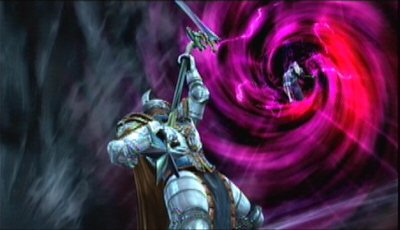
Zasalamel makes Taki pay for turtling by sending her into the void. Critical Finishes encourage and reward aggressive play.
(A+B+G+K during Soul Crush)
Review by Jay Wilson It was with initial disappointment that I noted SoulCalibur IV skimped on the extra features. It opens with an underwhelming intro that pales compared to its predecessors. It goes on to tell a ridiculous and incomprehensible story where battles take place on bland stages to uninspired music. It abandons standard fighting game modes of play such as Team Battle and Time Attack (not to mention the character profiles and Battle Theater from SCII & III.) Then after a moment’s pause, I realized, “wait a minute ... isn’t this what I’ve been waiting for?” For years, fighting games felt the need to expand beyond their core concept. At first it was simple variations—Team Battle, Survival Mode, and Time Attack Mode. Eventually the idea expanded to include extra mini-games. And SoulCalibur III went crazy with character creation, Chronicles of the Sword, and a whole array of game modes with the ‘Soul Arena’ (such as fighting a giant statue, collecting coins, a version of hot potato, et cetera.) And so I return to that question: haven’t I been waiting for a fighting game to come along and cut through the crap? To focus on the fighting again? Who cares about the fluff? Let's talk about something important. Let's talk about how this fighter plays. To test the waters, I selected the character with whom I was most familiar, Taki. Right away, her moveset seemed greatly reduced, but somehow more effective. For example, she lost her uppercut-slash and a neat looking 8-way run combo that swept enemies off their feet. Do I miss them? Not really, no. The uppercut was nearly useless in II, and IV gave her a combo that covers the same ground and transitions into her Possession stance which is infinitely more useful (not to mention fun.) As for her 8-way-run combo? Again, no real loss. It was great for aesthetics, but pure suicide against veteran players. Besides, the tools she gained eclipses the ones she lost; the rhythm of her attacks was more fun; and most importantly she felt balanced against the rest of the cast. 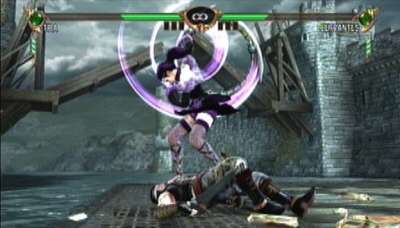
One of my favorite (counter) moves in the game. Tira’s Grim Reaper throw makes predictable attackers regret ever drawing their weapons against her. (B+K while Tira’s feeling Gloomy)
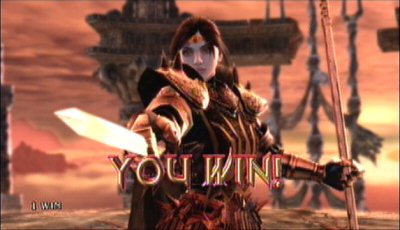
SCIV’s sole new character, Hilde, reigns supreme in the Ring Out department with her infamous “doom” combo.
(C3B 44K C2BB C3A C2BB C2AA) 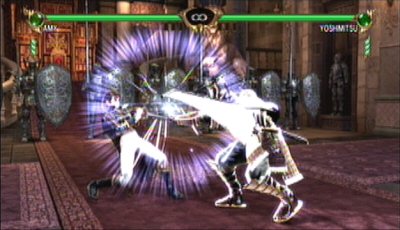
Some moves, called “just-inputs” require very strict timing and are accompanied by a white flash when executed properly such as Yoshimitsu’s Instant Manji-Carver Fist (2a:B).
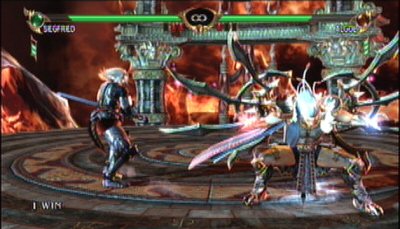
SCIV’s boss, Algol (right), can generate blades from his body, shoots bubbles (don’t ask), and fights with his throne (you just think I’m kidding.)
While Taki’s changes felt more like tweaks and refinements, other characters received more drastic changes. Tira, for example, received an entire overhaul. Now she has two different moods (Gloomy and Jolly) where her posture, her vocal inflections, and roughly half her moves change. Unlike characters with multiple stances (Siegfried) or weapon states (Ivy) where the player has absolute control, Tira’s moods can happen randomly during the fight (usually after taking damage.) So, you may find yourself attempting to perform a move exclusive to Tira’s Jolly mood, only to find she's slipped into Gloomy mood when you weren’t paying attention. Thus you have to stay on your toes when using her. And while there’s a few relatively reliable options to provoke the mood change, there’s no guarantee Tira will cross over when you want her to. It’s something different and unique. Hilde, the lone original character, uses a short sword and spear and introduces an entirely new mechanic to the Soul Series: charge moves. Holding the appropriate button down for various lengths of time will charge a special move which the player can unleash by releasing the button in question. Furthermore, Hilde has four stages of charges depending on how long the player holds said buttons. Stage One charges don’t have the juggle/Ring Out potential of the Stage Two and Stage Three charges (which can be chained together to form her infamous “doom” combo). Stage Four charges can damn near one-shot her opponents; however, good luck surviving those thirty seconds holding the button down. Amy, the kinda-sorta-not really new character, has gone from existing as a cameo in Raphael’s cutscenes in SCII to being a “bonus character” in SoulCalibur III to full blown main character. Despite her petite size and shorter range, she puts her parent(ish) figure to shame (much to the dismay of Raphael fans) with a slippery rapier style that can evade via sidestep, auto Guard Impact (aGI), and (more importantly) she’s nowhere near as linear as Raph and his tap-tap-step-lunge style (aka, Preperation). In other words, Amy absorbed everything good about her elder and left him with the junk (much like what Kilik did to Mina.) Algol, the boss, crosses great ideas with hideous ideas. The great? He is one with the swords, able to summon blades from his body at will, which would have thrown a neat new twist on the tired formula SC had fallen into with its past bosses where the swords possess their wielder. The hideous? Algol’s hands can also turn into small cannons that shoot—I kid you not—bubbles. Yes, bubbles. As if having a projectile-tossing character in a non-projectile based fighting game wasn’t bad enough, said projectile had to be purple bubbles. On the bright side, the bubbles can be guard-impacted (GIed) which sends them in the other direction which can lead to an unorthodox game of pong which, dear reader, I am ashamed to admit I have played and found amusing (in my defense, it was late and I was tired.) Naturally, it’d be impossible to explore the entire cast in detail. So, instead I’ll offer some generalized observations: #1. While it’s not uncommon to run across two characters who use similar weapons (Siegfried and Nightmare) or even share some moves (Yoshimitsu and Mitsurugi), all the characters play vastly different from one another. This coupled with the large cast offers a wide range of styles from Astaroth’s powerhouse destruction-in-a-handful-of-moves method, to Taki’s fast and relentless barrage of precision strikes, to Siegfried’s high-risk high-reward stance roulette, to Nightmare’s knack for Ringouts, to Setsuke’s just-input array, to Mina’s Soul Crush game, to Xianghua’s dizzying mixup of fake-outs, to the guest/bonus characters and their inappropriateness. 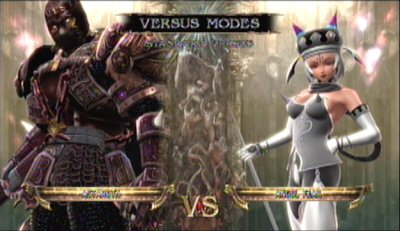
Namco-Bandai also included “bonus” characters designed by manga artists (Angol Fear, pictured right). Not only are they grossly inconsistent with SCIV’s design but most play like range-crippled versions of the main cast.

Fighting against each other on a Star Wars stage, Yoda and Vader (the guest characters) don’t stand out quite so blatantly. But, still, I wish they weren’t included at all.
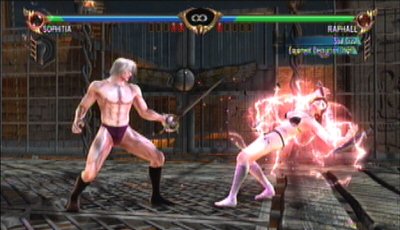
New to the Soul series: armor-breaking mechanics which can, in some instances, lead to your favorite characters sparring in their underwear.
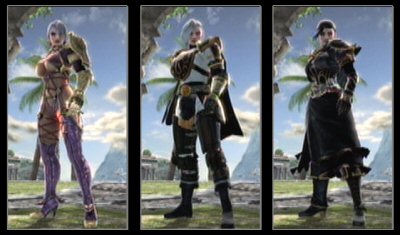
My versions of Ivy (center, right) won’t win any awards, but they’re way better than Namco’s stripper Ivy (left). Most people, though, seem content to just recreate Sephiroth, Afro Samurai, and any number of other game/anime characters.
#2. Speaking of which, the Bonus and Guest characters can go to hell. #3. Yoda can go to hell again. Not only does he suck (horrible step and crippled Soul Gauge), but his size renders half of everyone’s moves useless resulting in monotonous fights. And most importantly #4. to date, SCIV’s cast is the most balanced of any entry into the series (well, besides Hilde). Granted, like any fighting game, the characters fall into tiers where, for example, Cassandra is clearly stronger than, say, Rock; however, the gap between said tiers is much smaller than SCIII whose godlike Xianghua and Variable Cancel glitch killed off the competitive scene. Characters out of the way, let’s talk about game mechanics and features: First, SoulCalibur IV implements a far stricter buffering system. This is most evident in Ivy’s command throws (which have been reworked to accommodate the smaller window.) SCII & III allowed roughly five seconds to hit all six joystick inputs (an insanely huge window); SCIV gives you approximately one second which is more on par with any other fighting game out there. Even so, the pacing of IV has been slowed significantly from II perhaps to compensate for the stricter buffers. Second, SoulCalibur IV introduces a new mechanic that serves as a throwback to the weapon meter of Soul Edge/Blade—the Soul Gauge (ie. the orb at the end of the life gauge.) As a player blocks attacks, the Soul Gauge will drain, changing color from blue to green to red. When the whole lifebar flashes red, they’re on the verge of a Soul Crush and possibly a Critical Finish (a cinematic Fatality-like move) which ends the round instantly. The Soul Gauge can be replenished over time by not blocking, by performing parry GIs, and by landing attacks. Thus, curing the bane of many fighting games—the uber-defensive types who take the safe approach to ridiculous extremes, turning potentially interesting fights into a long monotony of guarding, periodically interrupted by the occasional timid offense. At the same time, it’s important to also note that the Soul Gauge has been balanced in such a way that defensive play is still possible; it’s just not abuseable. In actual play, Critical Finishes are a rarity reserved only for those who would find a cheap gimmick and whore it beyond all reason. Character Creation has existed in a number of fighting games now, but never really held my interest as the creations always strike me as painfully generic. Not only in physical appearance, but more importantly in gameplay. All custom characters are the same height, share the same hit boxes, and their weapons are scaled for their generic size. Contrast this with the main cast who are all different sizes, have unique hit boxes, and their weapons are scaled to their unique size. This will lead to anomalies in what a custom character can and cannot do. For example, Astaroth is much larger than any custom creation which allows him to hit from further away which lets him chain together attacks, forming combos that a custom character using Astaroth’s style cannot replicate. However, one facet of SCIV’s character creation does intrigue me—the ability to customize the main character’s wardrobe. Finally, I can hide Ivy and Taki’s ridiculous proportions under clothing, fix the God-awful colors of Raphael’s 2P outfit (a purple jacket? really?), and get Maxi out of Elvis impersonator mode. I could go on to discuss the different modes of play—Story Mode, Tower of Lost Souls, Arcade Mode—but the heart of any fighting game is in its multi-player (ie, Versus Modes, both Online and Local). You select your character, your opponent selects their’s, and the two of you battle it out. No AI can recreate the spontaneity, creativity, and unpredictability that makes playing another human being fun. Fighting the CPU in any mode is a monotonous mechanical exercise. After awhile, you start to notice the computer defends flawlessly against certain attacks (thanks to button reading), inexplicably walks into other attacks without ever learning, and uses freakishly unnatural attack patterns (good luck trying to learn a decent GI counter-game off the CPU.) 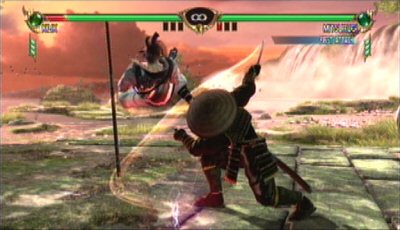
Mitsurugi’s Shin Slicer (1A), the most hated move online. It’s slow enough to defend against on-reaction offline, but online with input lag it’s difficult to avoid, thus, annoying as hell.
In Versus Mode, against a human opponent, SoulCalibur IV provides the tools and resources to have balanced, creative, interesting, and fun battles. Single Player Modes? I stopped caring about those a long time ago. If you're interested in that, then you're reading the wrong review. | ||||||||||||||||||||
|
| ||||||||||||||||||||
